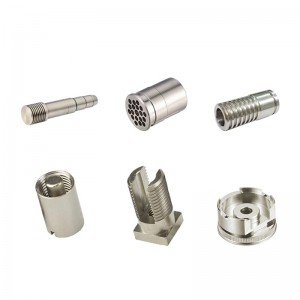Turning and milling composite machining parts
Product Specifications
Product advantages: no burr, batch front, surface roughness far exceeding ISO, high precision
Product name: Turning and milling composite machining parts
Product process: turning and milling compound
Product material: 304 and 316 stainless steel, copper, iron, aluminum, etc.
Material characteristics: good corrosion resistance, heat resistance, low temperature strength and mechanical properties
Product use: used in medical equipment, aerospace equipment, communication equipment, automotive industry, optical industry, precision shaft parts, food production equipment, drones, etc.
Accuracy: ±0.01mm
Proofing cycle: 3-5 days
Daily production capacity: 10000
Process accuracy: processing according to customer drawings, incoming materials, etc.
Brand Name: Lingjun
Advantages of turning and milling compound processing:
Advantage 1, Intermittent cutting:
The dual-spindle turning-milling combined machining method is an intermittent cutting method. This type of intermittent cutting allows the tool to have more cooling time, because no matter what material is processed, the temperature reached by the tool during cutting is lower .
Advantage 2, easy high-speed cutting:
Compared with the traditional turning-milling technology, this dual-spindle turning-milling combined processing technology is easier to perform high-speed cutting, so all the benefits of high-speed cutting can be reflected in the dual-spindle turning-milling combined processing, such as It is said that the combined cutting force of dual-spindle turning and milling is 30% lower than that of traditional high cutting, and the reduced cutting force can reduce the radial force of workpiece deformation, which can be beneficial to the processing of slender precision parts. And to increase the processing speed of thin-walled parts, and if the cutting force is relatively small, the burden on the tool and the machine tool is also relatively small, so that the accuracy of the dual-spindle turning-milling compound machine tool can be better protected.
Advantage 3, the workpiece speed is low:
If the rotation speed of the workpiece is relatively low, the object will not be deformed due to centrifugal force when processing thin-walled parts.
Advantage 4, small thermal deformation:
When using the dual-spindle turning-milling compound, the entire cutting process is already insulated, so the tool and chips take away a lot of heat, and the temperature of the tool will be relatively low, and thermal deformation will not occur easily.
Advantage 5, one-time completion:
The dual-spindle turning-milling composite mechanic machine tool allows all the tools to be processed to complete all the boring, turning, drilling, and milling processes in one clamping process, so that the trouble of replacing the machine tool can be greatly avoided. Shorten the cycle of workpiece production and processing, and avoid problems caused by repeated clamping.
Advantage 6, reduce bending deformation:
Using the dual-spindle turning-milling composite machining method can greatly reduce the bending deformation of the parts, especially when processing some thin and long parts that cannot be supported in the middle.
3.2. Dimensional accuracy requirements
This paper analyzes the requirements of the dimensional accuracy of the drawing, so as to judge whether it can be achieved by turning process, and determine the process method to control the dimensional accuracy.
In the process of this analysis, some dimension conversion can be carried out at the same time, such as the calculation of incremental dimension, absolute dimension and dimension chain. In the use of CNC lathe turning, the required size is often taken as the average of the maximum and minimum limit size as the size basis of programming.
4.3. Requirements for shape and position accuracy
The shape and position tolerance given on the drawing is an important basis to ensure the accuracy. During machining, the positioning datum and measurement datum should be determined according to the requirements, and some technical processing can be carried out according to the special needs of the CNC lathe, so as to effectively control the shape and position accuracy of the lathe.
five point five
Surface roughness requirements
The surface roughness is an important requirement to ensure the surface micro precision, and it is also the basis for reasonable selection of CNC lathe, cutting tool and determination of cutting parameters.
six point six
Material and heat treatment requirements
The material and heat treatment requirements given in the drawing are the basis for selecting cutting tools, CNC lathe models and determining cutting parameters.
Five axis vertical machining center

Large CNC machine tools

Introduction of large CNC machine tool 3












